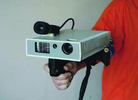

















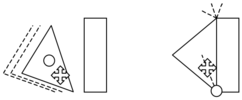


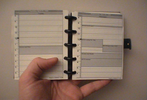










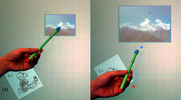




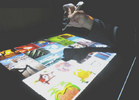


We introduce Shadow Reaching, an interaction technique that makes use of a perspective projection applied to a shadow representation of a user. The technique was designed to facilitate manipulation over large distances and enhance understanding in collaborative settings. We describe three prototype implementations that illustrate the technique, examining the advantages of using shadows as an interaction metaphor to support single users and groups of collaborating users. Using these prototypes as a design probe, we discuss how the three components of the technique (sensing, modeling, and rendering) can be accomplished with real (physical) or computed (virtual) shadows, and the benefits and drawbacks of each approach.


We describe a unique form of hands-free interaction that can be implemented on most commodity computing platforms. Our approach supports blowing at a laptop or computer screen to directly control certain interactive applications. Localization estimates are produced in real-time to determine where on the screen the person is blowing. Our approach relies solely on a single microphone, such as those already embedded in a standard laptop or one placed near a computer monitor, which makes our approach very cost-effective and easy-to-deploy. We show example interaction techniques that leverage this approach.


In this paper, we extrapolate the evolution of mobile devices in one specific direction, namely miniaturization. While we maintain the concept of a device that people are aware of and interact with intentionally, we envision that this concept can become small enough to allow invisible integration into arbitrary surfaces or human skin, and thus truly ubiquitous use. This outcome assumed, we investigate what technology would be most likely to provide the basis for these devices, what abilities such devices can be expected to have, and whether or not devices that size can still allow for meaningful interaction. We survey candidate technologies, drill down on gesture-based interaction, and demonstrate how it can be adapted to the desired form factors. While the resulting devices offer only the bare minimum in feedback and only the most basic interactions, we demonstrate that simple applications remain possible. We complete our exploration with two studies in which we investigate the affordance of these devices more concretely, namely marking and text entry using a gesture alphabet.


We present Abracadabra, a magnetically driven input technique that offers users wireless, unpowered, high fidelity finger input for mobile devices with very small screens. By extending the input area to many times the size of the device's screen, our approach is able to offer a high C-D gain, enabling fine motor control. Additionally, screen occlusion can be reduced by moving interaction off of the display and into unused space around the device. We discuss several example applications as a proof of concept. Finally, results from our user study indicate radial targets as small as 16 degrees can achieve greater than 92% selection accuracy, outperforming comparable radial, touch-based finger input.


PhoneTouch is a novel technique for integration of mobile phones and interactive surfaces. The technique enables use of phones to select targets on the surface by direct touch, facilitating for instance pick&drop-style transfer of objects between phone and surface. The technique is based on separate detection of phone touch events by the surface, which determines location of the touch, and by the phone, which contributes device identity. The device-level observations are merged based on correlation in time. We describe a proof-of-concept implementation of the technique, using vision for touch detection on the surface (including discrimination of finger versus phone touch) and acceleration features for detection by the phone.






